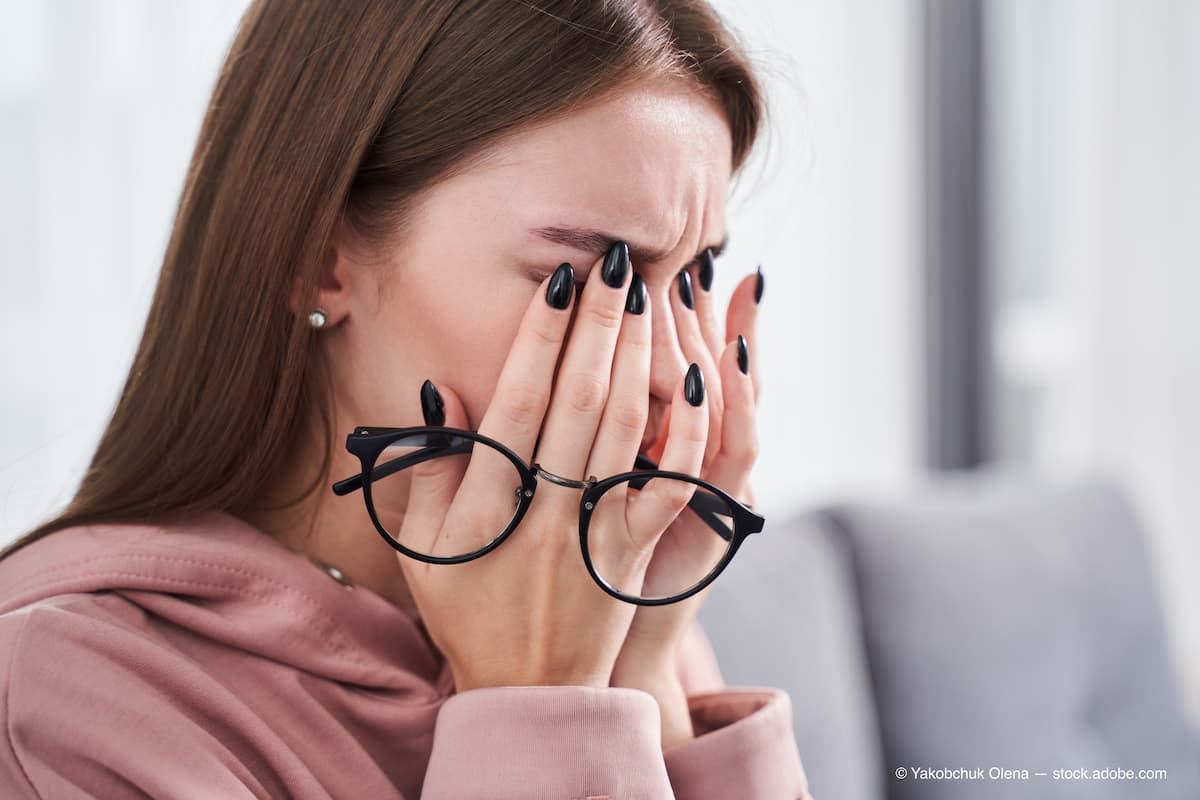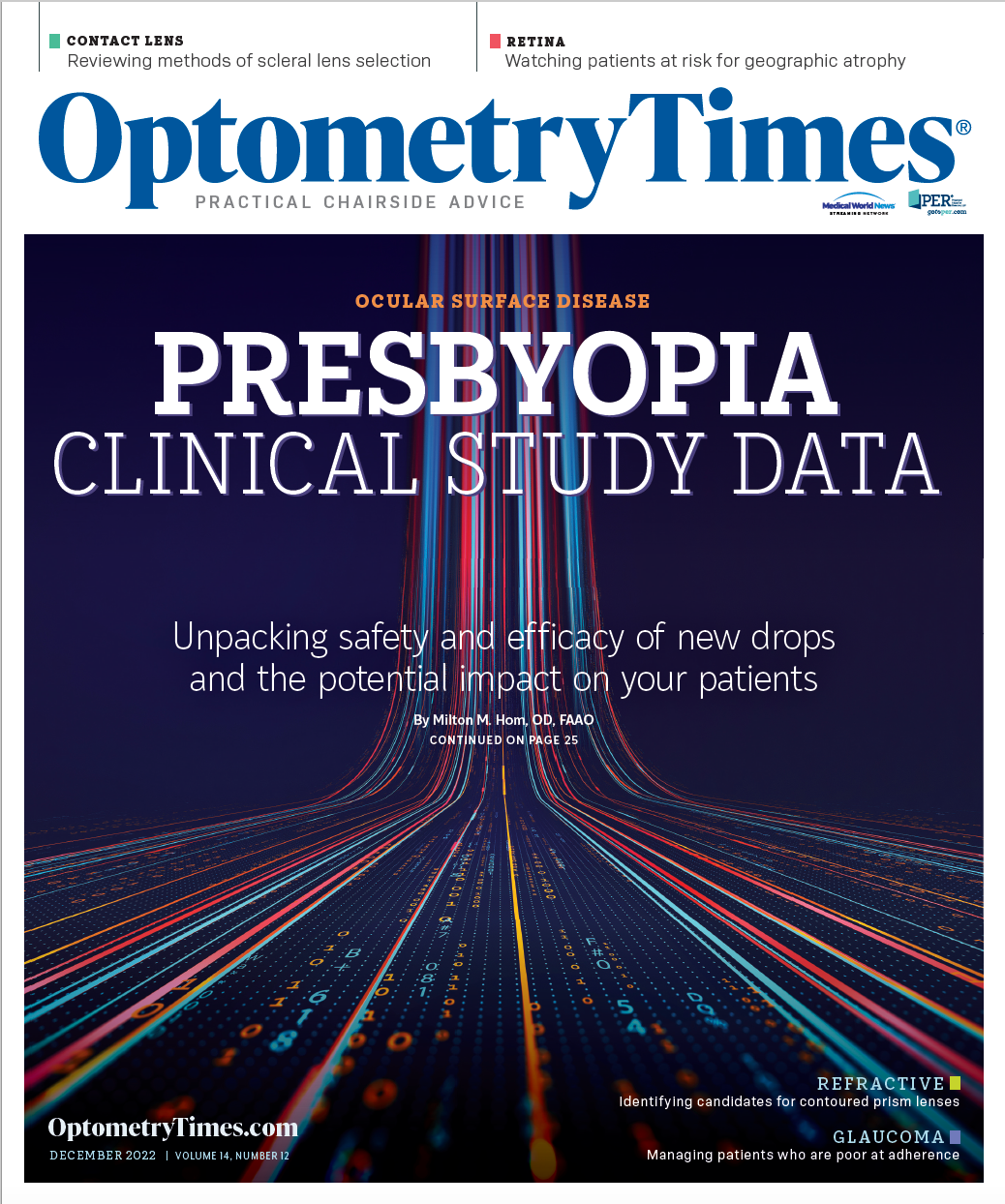New technologies in the clinic: Combining light-based therapies for the treatment of dry eye
When combined, intense pulsed light and low-level light therapy—both of which have roots in dermatology—create a synergistic effect that treat dry eye more effectively than one therapy alone.

Online exclusive content
We are fortunate to have so many new options for treating dry eye disease in recent years. Two new technologies that we have been using in our clinic, Stanford Ranch Optometry, are intense pulsed light (IPL) and low-level light therapy (LLLT). Both are light-based therapies that work in slightly different ways. When they are used together, the effects are synergistic and produce a better outcome.
IPL
IPL has been used to treat a variety of conditions in dermatology for many years. It was developed as a treatment for leg telangiectasia and was approved by the FDA in 1995 to treat vascular lesions.1 IPL has been used to treat many dermatological conditions, including pigmented lesions, acne, and rosacea erythema, as well as aesthetic treatments such as fine wrinkle reduction and hair reduction.
In 2005, Rolondo Toyos, MD, published a case report where he demonstrated the improvement in tear breakup time (TBUT) and Schirmer scores after 4 consecutive, monthly IPL treatments.2 Toyos proposed that the improvement of dry eye signs after IPL was due to the stimulation of meibomian glands or the decrease in facial and eyelid telangiectasia.2
Since then, the use of IPL to treat ocular rosacea, meibomian gland dysfunction (MGD), and dry eye has gained popularity. Numerous studies have shown the benefit of IPL to treat dry eye. In 2021, Optilight (Lumenis) became the first IPL device to gain FDA approval for the treatment of MGD and dry eye. Many other IPL devices are on the market but do not have FDA approval for treatment of dry eye.
IPL is a light-based therapy that works within the visible light spectrum. Certain wavelengths and filters are used to treat specific skin and eyelid conditions based on the patient’s skin type and the desired depth of the treatment. The patient’s skin type is determined by using the Fitzpatrick skin type scale. IPL works best on patients with skin types I to IV.
IPL’s mechanism of action, Toyos explains, is that “the light that is emitted is absorbed by the oxyhemoglobin in the blood vessels on the skin’s surface; the absorption generates heat that coagulates the cells, leading to thrombosis of the blood vessels.”3 Rosacea patients have abnormal blood vessels on their skin surface. When a trigger—such as heat, food, stress, alcohol, or microbes—worsens a patient’s rosacea, these abnormal blood vessels release proinflammatory mediators such as cytokines and chemokines.4
“By closing off the blood vessels near the surface of the skin it decreases the inflammatory cytokines that contribute to meibomian gland dysfunction,” Toyos explains.3 Thus, by decreasing inflammation, we are treating the root cause of the MGD and dry eye disease. Other possible mechanisms for how IPL helps dry eye and MGD include generating heat that helps melt the meibum and opens up the meibomian glands, decreasing the bacterial load on the skin, and decreasing parasites such as Demodex on the eyelash margin.3
IPL works best on patients with facial and ocular rosacea, which often presents concurrently with MGD and dry eye. Our office uses the Optilight device by Lumenis. Each patient is treated at least 4 times with 3 to 4 weeks between treatment sessions. The patient wears laser-grade eye protection during each treatment. Before the treatment, the patient washes their face to remove any makeup, sunscreen, or oils. Clear ultrasound gel is applied to the face and the treatment is performed. Each treatment is individualized based on the patient’s skin type.
Overall, IPL is a safe and well-tolerated procedure. Care should be taken to treat the patient with the correct skin type and wavelength filter to avoid adverse skin reactions such as burns, bruising or blistering.
LLLT
LLLT or photobiomodulation is another technology gaining popularity for the treatment of dry eye. The procedure that is also often used in dermatology; it has traditionally been used for aesthetics (reducing fine lines and wrinkles), acne treatment, pain management, wound healing, and hair restoration.
To understand how LLLT therapy works, let’s dive deeper into the definition of photobiomodulation. Photobiomodulation is a therapy that utilizes various forms of light, including light-emitting diodes (LEDs). Photobiomodulation therapy has been as defined as “a nonthermal process involving endogenous chromophores eliciting photophysical and photochemical events at various biological scales.”5 The definition goes on to say, “This process results in beneficial therapeutic outcomes including…alleviation of pain or inflammation, immunomodulation and promotion of wound healing and tissue regeneration.”5 Therefore, it makes sense to use photobiomodulation to treat dry eye disease since many of our current therapeutic options also focus on decreasing pain and inflammation, immunomodulation, wound healing and tissue regeneration.
In LLLT, LEDs of various wavelengths are used. Most commonly, the wavelengths used are red, near infrared, blue and sometimes yellow. During LLLT, the initial photon absorption occurs in the mitochondria.6 LLLT can modulate immune system responses and reduce inflammation.6 In fact, 1 of the most reproduceable effects of photobiomodulation is an overall reduction in inflammation.7 Red and near infrared light are used to decrease inflammation and blue light kills bacteria. LLLT is being used in eye care to treat MGD, blepharitis, chalazia, and hordeola. During LLLT, the power is low to reduce damage to the treated tissue compared with IPL, in which the power is much higher.

There are many LLLT devices on the market. Three devices currently used in the eye care industry are Celluma (BioPhotas, Inc), Equinox (Marco), and Epi-C Plus (Marco). Treatments can last between 15 and 30 minutes and are noninvasive and pain-free. No ultrasound gel is required. Patients should have a clean face prior to treatment, free from makeup, sunscreen, or moisturizer. No eye protection is required, but eyes remain closed during the treatment. Results are best when the LED lights are placed as close to the eyelid as possible.
One study in 2022 with 40 dry eye patients showed a significant improvement in fluorescein staining in the group treated with LLLT vs the placebo group.8 Another study from 2020 with 15 MGD patients treated with LLLT showed a significant improvement in dry eye symptoms and noninvasive tear breakup time.9 Currently LLLT is not FDA approved for the treatment of dry eye, so any use would be off label. There are also no specific protocols for eye-related conditions. More studies need to be done to determine the most beneficial wavelength of light, concentration of lights, treatment time length, number of sessions, and length of time in between sessions.
In our clinic, we find a huge benefit from doing a combination of IPL, LLLT, and manual expression. After each IPL treatment with the Optilight from Lumenis, we have the patient wash off the ultrasound gel and sit under the Celluma for a 30-minute LLLT treatment. After the LLLT we do an optional manual expression for any meibomian glands that are still obstructed. We do these treatments every month for 4 consecutive months. All procedures are well tolerated and safe with little to no downtime for the patient. The results have been overwhelmingly beneficial and effective, with life-changing results for many of our patients. We are excited to offer these innovative and powerful technologies to combat dry eye disease.
References
Almukhtar R, Carr E, Goldman M. Intense pulsed light: the early years. Dermatological Reviews. October 10, 2020. Accessed September 1, 2022. https://clderm.com/wp-content/uploads/2021/01/intense-pulsed-light-the-early-years.pdf
Toyos R, Buffa C, Youngerman S. First paper ever on intense pulse light IPL for dry eye disease. Toyos Clinic. March 19, 2020. Accessed September 1, 2022. https://toyosclinic.com/blog-feed/jpst1fb36fd0roveb4jddg2hgveaf5
Kent C. Intense pulsed light: for treating dry eye.” Review of Ophthalmology. November 16, 2010. Accessed September 1, 2022. https://www.reviewofophthalmology.com/article/intense-pulsed-light-for-treating-dry-eye
Gerber PA, Buhren BA, Steinhoff M, Homey B. Rosacea: the cytokine and chemokine network. J Investig Dermatol Symp Proc. December 1, 2011. Accessed September 1, 2022. 2011;15(1):40-47. doi:10.1038/jidsymp.2011.9
Anders JJ, Lanzafame RJ, Arany PR. Low-level light/laser therapy versus photobiomodulation therapy. Photomed Laser Surg. 2015;33(4):183-184. doi:10.1089/pho.2015.9848
Thomas C. Understanding photobiomodulation therapy. Modern Optometry. July 2021. Accessed November 8, 2022. https://modernod.com/articles/2021-july-aug/understanding-photobiomodulation-therapy?c4src=article%3Ainfinite-scroll
Hamblin MR. Mechanisms and applications of the anti-inflammatory effects of photobiomodulation. AIMS Biophys. 2017;4(3):337-361. doi:10.3934/biophy.2017.3.337
Park Y, Kim H, Kim S, Cho KJ. Effect of low-level light therapy in patients with dry eye: a prospective, randomized, observer-masked trial. Sci Rep. 2022;12(1):3575. doi: 10.1038/s41598-022-07427-6
Pult H. Low-level light therapy in the treatment of meibomian gland dysfunction. ARVO Journals. June 2020. Accessed November 8, 2022. https://iovs.arvojournals.org/article.aspx?articleid=2769219Marta A, Baptista PM, Heitor Marques J, et al. Intense pulsed plus low-level light therapy in meibomian gland dysfunction. Clin Ophthalmol. 2021;15:2803-2811. doi:10.2147/OPTH.S318885
Marta A, Baptista PM, Heitor Marques J, et al. Intense pulsed plus low-level light therapy in meibomian gland dysfunction. Clin Ophthalmol. 2021;15:2803-2811. doi:10.2147/OPTH.S318885
Stonecipher K, Abell TG, Chotiner B, Chotiner E, Potvin R. Combined low level light therapy and intense pulsed light therapy for the treatment of meibomian gland dysfunction. Clin Ophthalmol. 2019;13:993-999. doi:10.2147/OPTH.S213664
Solomos L, Bouthour W, Malclès A, Thumann G, Massa H. Meibomian gland dysfunction: intense pulsed light therapy in combination with low-level light therapy as rescue treatment. Medicina (Kaunas). 2021;57(6):619. doi:10.3390/medicina57060619
D’Souza S, Padmanabhan Nair A, Iyappan G, et al. Clinical and molecular outcomes after combined intense pulsed light therapy with low-level light therapy in recalcitrant evaporative dry eye disease with meibomian gland dysfunction. Cornea. 2022;41(9):1080-1087. doi:10.1097/ICO.0000000000002954
Di Marino M, Conigliaro P, Aiello F, et al. Combined low-level light therapy and intense pulsed light therapy for the treatment of dry eye in patients with Sjögren’s syndrome. J Ophthalmol. 2021;2021:2023246. doi:10.1155/2021/2023246

Newsletter
Want more insights like this? Subscribe to Optometry Times and get clinical pearls and practice tips delivered straight to your inbox.